Traditional Bolognese Sauce
The rave reviews say it all. See them all below! This is the only traditional Bolognese sauce recipe (Ragu alla Bolognese) you need. Made with all the authentic ingredients like beef, pork, and fresh tomato purée, it’s one of the most popular and comforting Italian dishes.
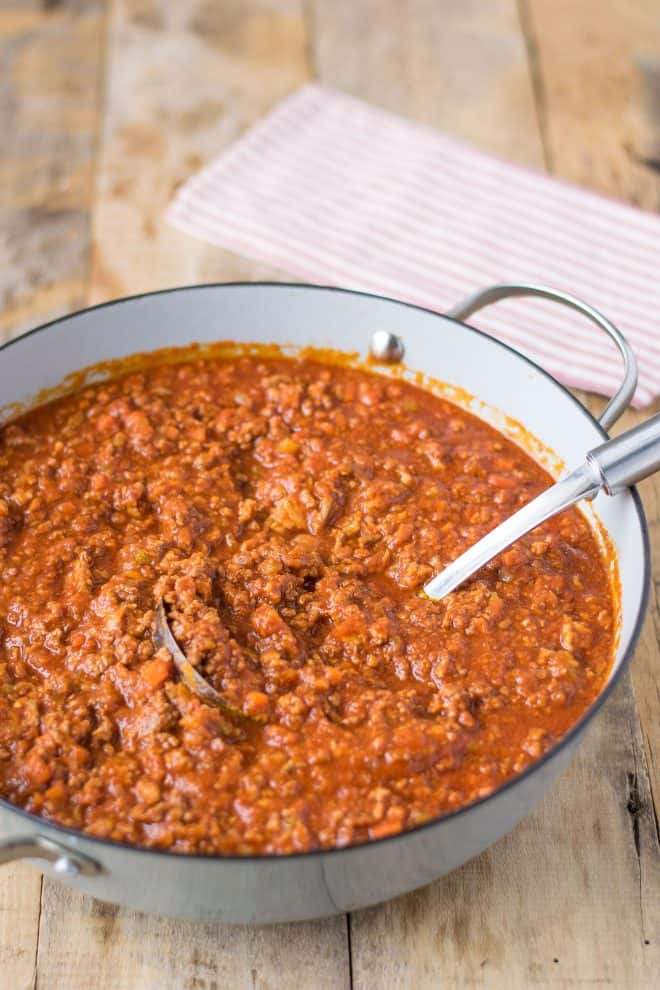
I originally developed and published this recipe back in 2017. The recipe hasn’t changed, but I’ve added some valuable information to read, as well as a video.
This sauce is cooked low and slow for 4 hours to develop a rich, hearty taste. My recipe makes a lot of sauce, and trust me, you’ll want more. Plus, it freezes really well. It’s the sauce that just keeps on giving.
Traditional Sauce from Bologna, Italy
Now, why do I say this is a traditional recipe? Because it has the same ingredients as the authentic Bolognese recipe from the home of Bolognese, the Chamber of Commerce, Industry, Craftsmanship, and Agriculture of Bologna, to be official.
Bolognese Sauce Ingredients
When you might expect oregano or basil in an Italian recipe, the seasonings in Bolognese are very minimal. Only salt and pepper are used.
The other ingredients are ground beef, ground pork, onion, carrot, celery, wine, tomato purée/passata, milk, and beef broth.
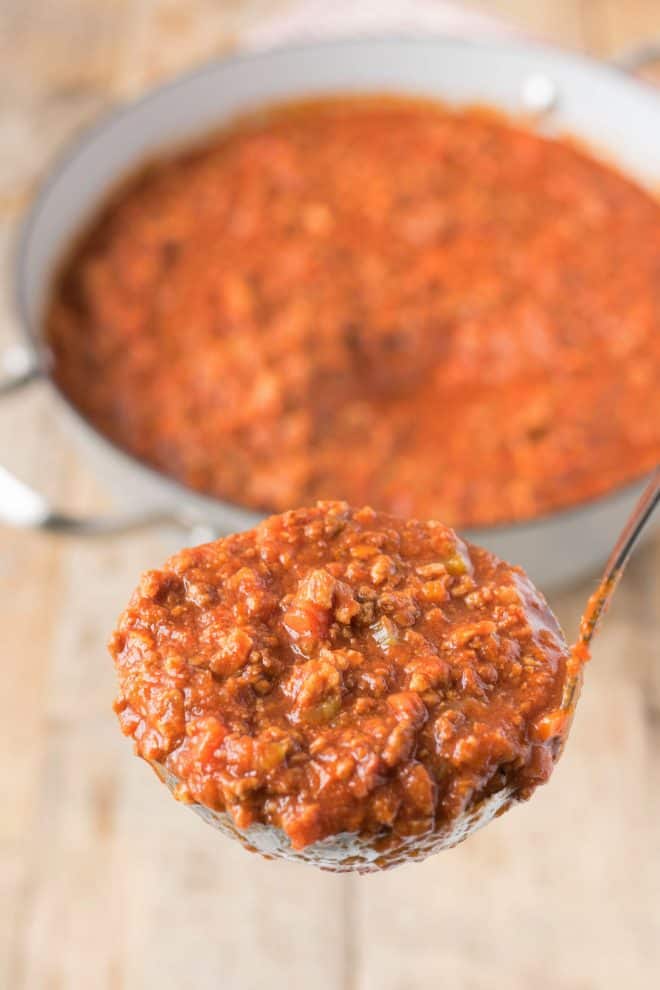
THE BEST BOLOGNESE SAUCE IS COOKED LOW AND SLOW
A traditional Bolognese sauce is a rich, thick meat sauce that needs to cook for 4 hours. Yes, 4 hours! Trust me (I make this almost weekly), and you can read the comments to back this
I’ve had people say (and I agree) that after 2 hours, it seems like it’s ready and it’s pretty good, 3 is even better, but 4 is best.
Milk in Bolognese Sauce
A few people have asked questions about adding the milk and how it seems weird. It’s not weird, as it serves a good purpose, plus, it’s how they do it in Italy. It helps to tenderize the meat, and after 4 hours, you won’t even notice it’s in there.
What are the best meats to use for Bolognese?
Usually 50% each of ground beef and pork is used with a really great flavor booster, pancetta (Italian unsmoked bacon). You can use all beef if you’re not a pork eater.
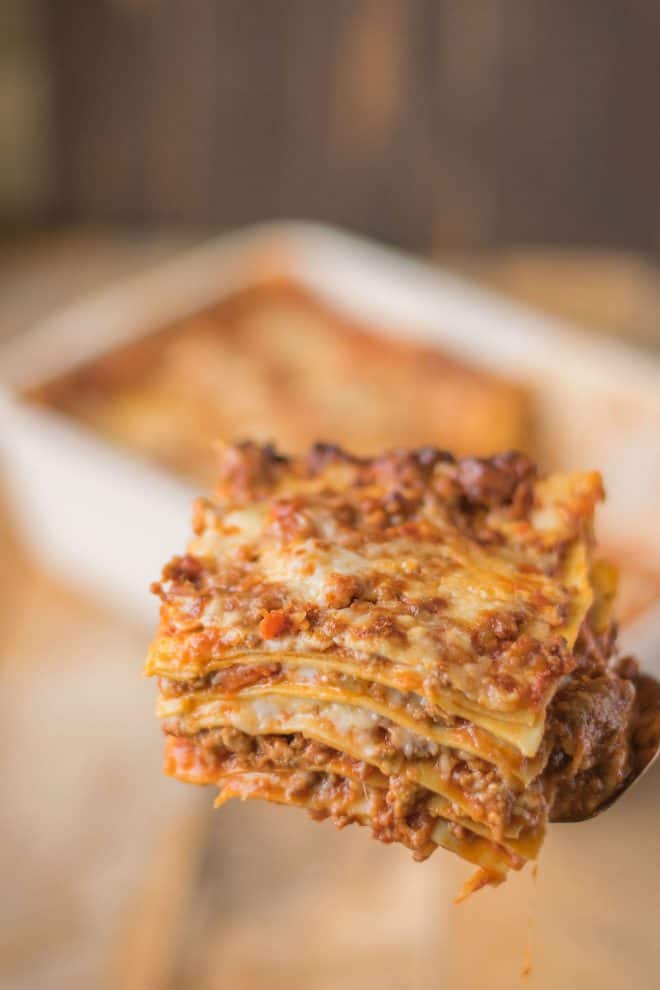
Tomato Sauce/Purée/Passata
The tomato base for this sauce are good, strained tomatoes from a jar or can that have no other ingredients that is a thick, liquid consistency. This product is called by a few different names around the world, purée, passata or sauce (not tomato ketchup which is also called tomato sauce in the U.K and Australia).
WHITE OR RED WINE IN BOLOGNESE
I like white wine, and and white is traditional, but you can use red if you prefer.
What can you make with this Bolognese?
This sauce is not only used in my Lasagna Bolognese, it can also be served with wide, flat tagliatelle, a pasta that can hold the weight of the sauce.
HOW MUCH SAUCE DOES THIS RECIPE MAKE?
This recipe yields 4 quarts/16 cups/3.7 liters of sauce. You will need a large pan for this and the reason I made so much is because this sauce is going in a lasagna Bolognese (which is also very large and really good!)
WHAT IS THE DIFFERENCE BETWEEN A RAGU AND BOLOGNESE?
Both are Italian meat sauces with slight differences, but they are both made with meat and it’s the choice of meats that make the difference in the sauces. Bolognese (Ragu all Bolognese) originates from Bologna, Italy. Simply named Ragu is from Naples Italy. They both use soffritto (carrots, celery, pancetta) beef broth and tomato sauce.
WHAT IS A MARINARA SAUCE?
Marinara is a tomato based sauce that has not meat. I have an easy recipe for this sauce here easy homemade marinara sauce.
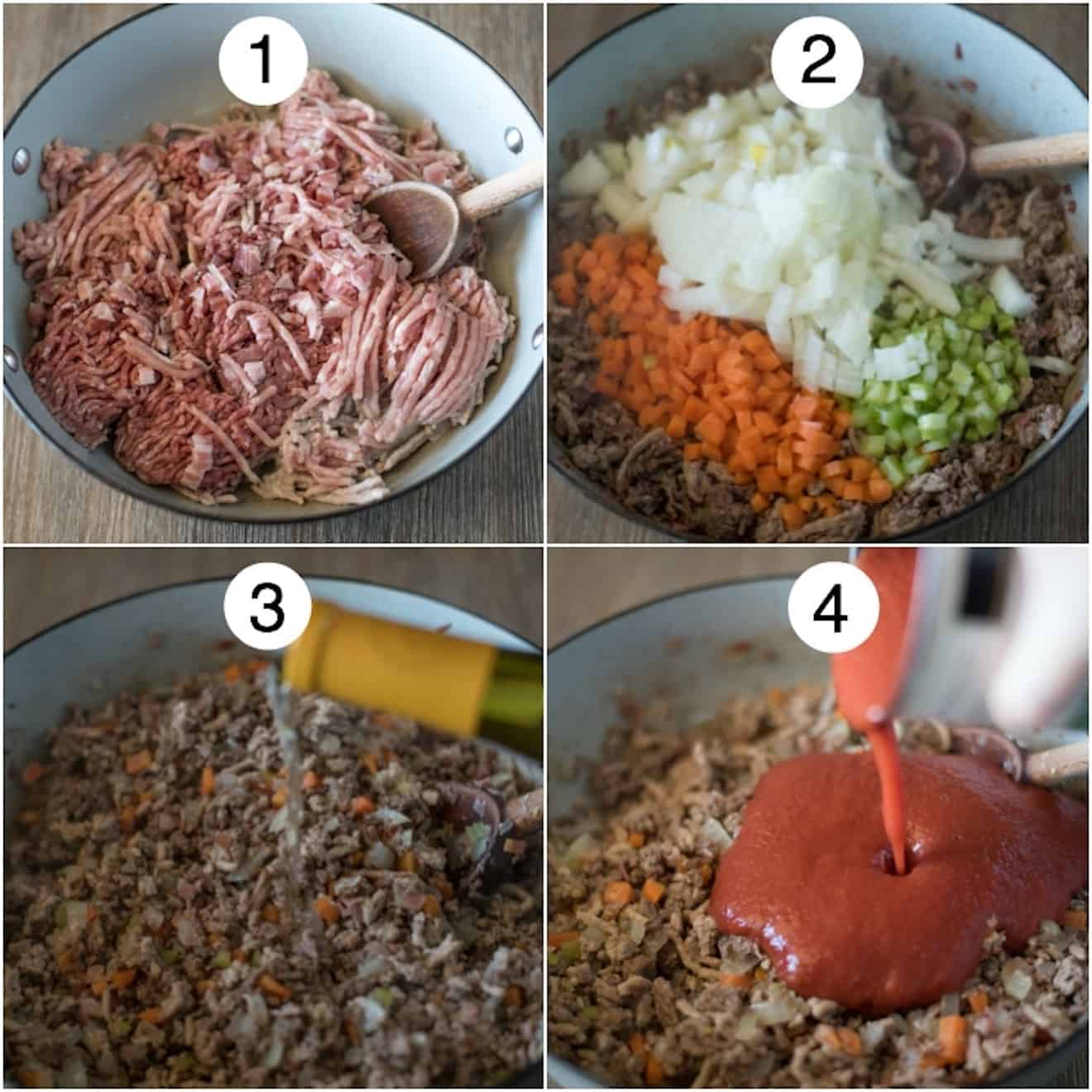
How to Make Traditional Bolognese Sauce – Step by Step
- Cook the meat and vegetables
Brown the beef, pork and pancetta, salt and pepper in olive oil and butter.
- Add the veggies
Chopped onion, celery and carrot, then garlic (optional).
- Add the wine
Stir in the wine and reduce a little.
- Add the other liquids
Add the tomato puree/passata, beef stock and milk. Mix, partially cover and leave for 4 hours.
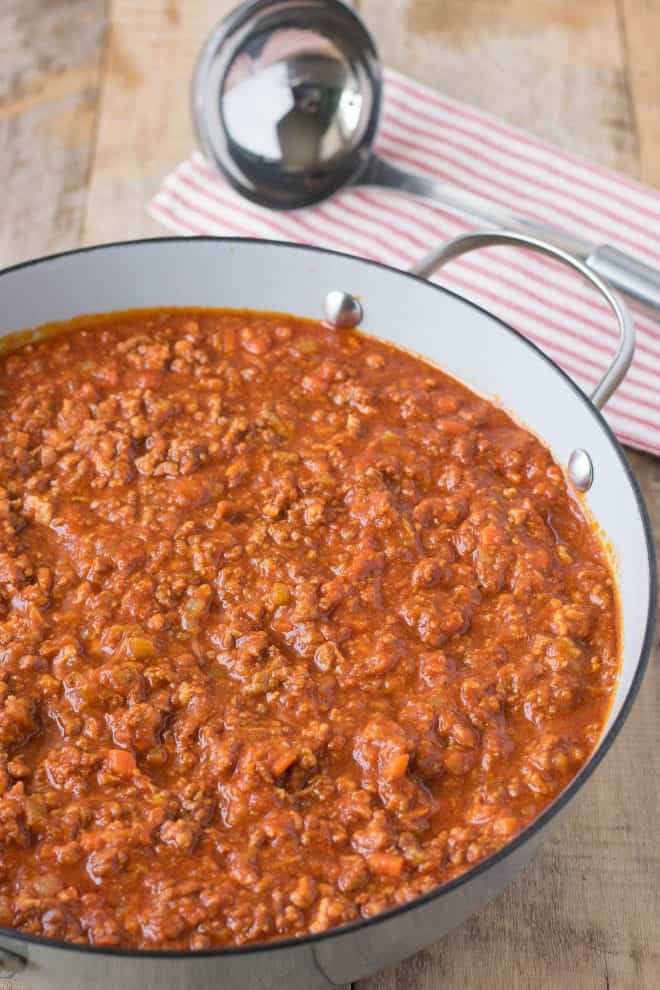
Note: There is no garlic in Traditional Bolognese Sauce, but I have added it as an optional ingredient to the recipe for those asking for it.
Slow Cooker Bolognese Method
This sauce cooks perfectly in the slow cooker. Prepare as the recipe instructs and after step 3, transfer the sauce to a slow cooker pre-heated on high and let it cook away for 4 hours.
The sauce will become quite saucy with the lid on as it produces liquid, so remove the lid to help the sauce thicken.
Freezing Bolognese Sauce
I know that this recipe makes a lot of sauce, but it is so good I always make a full batch and freeze the rest because I end up craving it. To freeze any cooked leftovers, add the cooled sauce to a container with a good lid and seal well. You can keep it frozen for 3 months. To reheat, defrost in the fridge overnight and reheat in a pan.
How to Thicken Bolognese Sauce
This recipe thickens as it cooks for 4 hours. If you find that your sauce is not thickening after the 4 hour or is too thin (this could be the result of the meat or vegetables giving off liquid), remove the lid completely and turn up the heat so the sauce bubbles rapidly.
This will allow the excess liquid to evaporate, but you MUST stir the sauce often to prevent it sticking to the bottom of the pan.
What to do if Bolognese Sauce is Too Thick
If the sauce is thickening too quickly as it simmers, turn the heat down and cover completely. If your leftovers are too thick (this can happen when the sauce is cold), add to a pan and reheat over medium heat, stirring.
When you warm up the sauce and it is to thick, add a little beef stock. You can also add more tomato puree/passata. You want to reheat slowly to see how much liquid the sauce needs as it heats and add accordingly.
Did you know there is a white Bolognese sauce?’ It’s true, but it’s not exactly white. The name just means it does not have any tomato product added. I recently added my own recipe here: Traditional White Bolognese Sauce. Picture below.
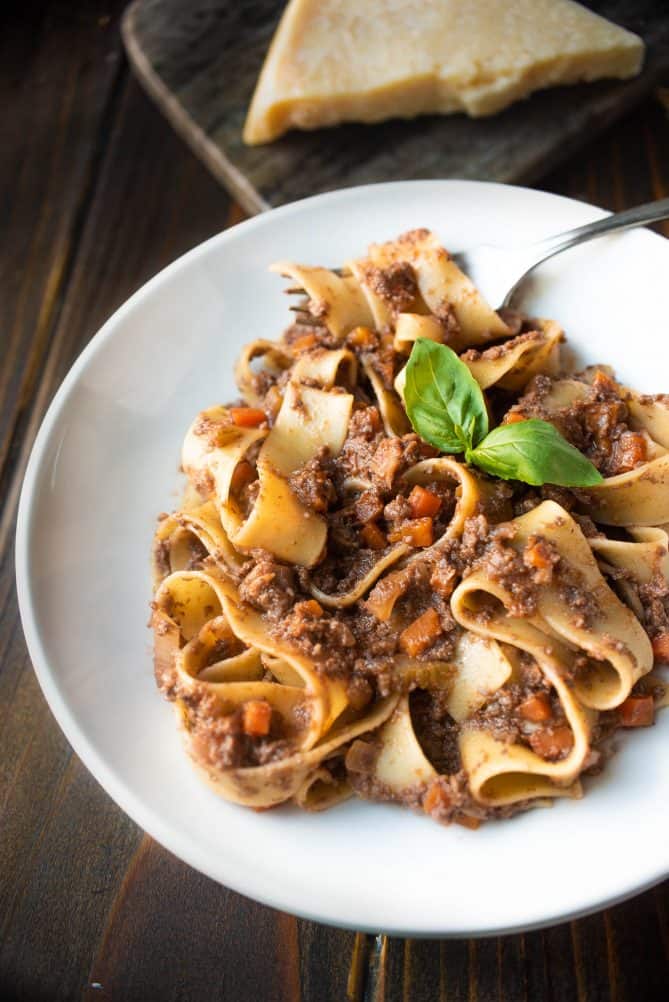
Traditional Bolognese Sauce
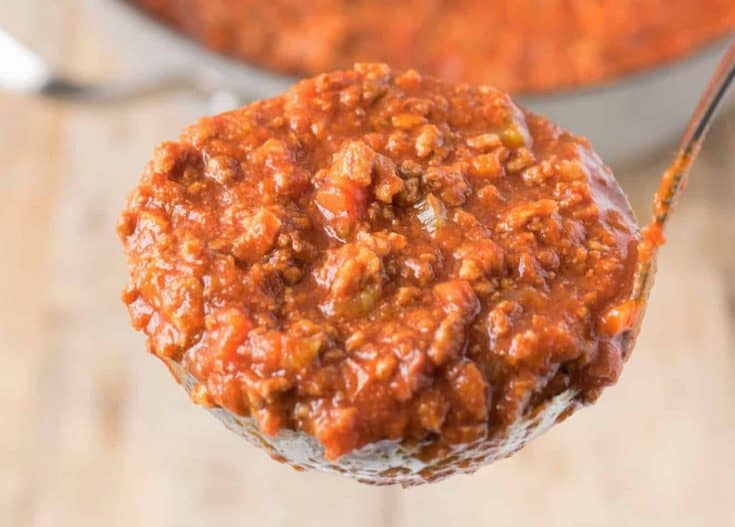
This traditional Bolognese sauce is made using all the authentic ingredients like beef, pork, fresh tomato purée, then cooked low and slow for hours to develop a rich, hearty taste.
Ingredients
- 1 tablespoon olive oil
- 1 tablespoon unsalted butter
- 1 ½ pounds (680 grams) 80/20 ground beef
- 1 ½ pounds (680 grams) ground pork
- 6 ounces (170 grams) pancetta, chopped finely
- ½ teaspoon salt
- ¼ teaspoon black pepper
- 11 ounces (311 grams) large onion, finely chopped
- 2 celery stalks, finely chopped
- 6 ounces (1 large) carrot, finely chopped
- 5 garlic cloves, grated or finely chopped (optional, see note)
- 1 cup (236 ml) white wine, or red if you prefer * see note
- 3 1/2 cups (794 grams) 28 ounces good quality can tomato puree/passata,
- 1 cup (236ml) milk
- 1 cup (236 ml) beef stock (low sodium if possible) * see note
Instructions
- To a large, wide pan or a large high-sided skillet. Add the oil and butter over medium-high heat. When the butter is melted and bubbly, add the beef, pork, pancetta, salt, pepper. Brown, breaking up the meat while cooking.
- When the meat is browned, add the onion, celery and carrots, mix well and cook for 3 minutes. Stir in the garlic and cook for 2 more minutes.
- Add the wine, stir and allow to cook and reduce slightly for about 3 minutes. Add the tomato purée, milk, stock and mix well.
- Partially cover and simmer for 4 hours, stirring often to prevent it sticking to the bottom. If any fat rises to the top, use a spoon to skim it off.
- If you find that the liquid is not reducing, remove the lid completely and make sure the sauce is bubbling. It may get messy.
- When done, taste for seasoning and adjust to your taste.
Notes
Garlic is not traditional, but I have had many requests as to how much to add so it is included in the recipe.
Taste your stock, if it is salty, you may need to adjust the amount of salt in the dish
White wine is traditional. A good tasting wine like Pinot Grigio. If you use red, it may taste different as there are tannins in red wine and it could make it bitter depending on the wine variety.
Nutrition Information
Yield
16Serving Size
1 cupAmount Per Serving Calories 270Total Fat 18gSaturated Fat 7gTrans Fat 0gUnsaturated Fat 10gCholesterol 57mgSodium 171mgCarbohydrates 9gFiber 2gSugar 4gProtein 16g
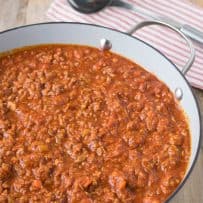
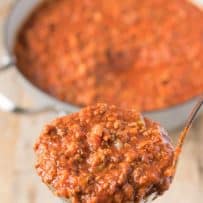
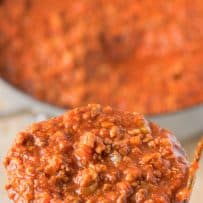
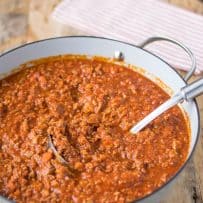

268 Comments on “Traditional Bolognese Sauce”
Great recipe, thank you. My daughter loves it. I scale up using 2Kg of mince to batch cook and freeze. The milk adds a subtle creaminess to the sauce. Defrost and zap in the microwave while cooking spaghetti (yes, I know, not traditional & should be tagliatelle) for a super quick & easy evening meal for a busy single parent. I do add garlic as I have southern Italian heritage. That’s the thing about Italian cooking. Every Nona in every village has their own secret ingredient. Making the recipe your own by adding Worcestershire sauce or dried herbs such as oregano is all good. Whatever floats your boat. I add leftover rinds of Parmesan before the 4 hour cook out. It adds a deep savoury flavour. Another tip is to leave on the stove off the heat overnight for the flavours to mature and develop before portioning and freezing/chilling.
Thank you so much for sharing and the feedback.
Do you drain the grease after cooking the meat?
You can drain the fat if you like. The amount of fat will depend on how fatty your pancetta is and the meat. Enjoy.
I use my basic tomato sauce so it already has garlic and all the good stuff in it. Follow recipe for rest of the sauce. Very good.
Thank you for the feedback
I’ve made this and the companion lasagna recipe twice now, and am doing it a 3rd time tomorrow in honor of the long-awaited cold front here in central Texas! My mom is lactose intolerant, so I used lactose-free whole milk and seriously aged (20+mos) parmesan. Used lasagna sheets from a local fresh pasta shop. The 1st time I made it for my Mom – who doesn’t eat much at any meal – she went back for seconds! Individual portions freeze beautifully. I use the leftover sauce on reheated leftover portions or pour over whole wheat pasta. Thank you so much for this recipe. Yes, it’s time consuming but the result is well worth the time and labor, and the simmering sauce makes the kitchen smell like an Italian nonna’s house!
Thank you so much for the feedback
I have made it a couple times ,we love it!
Thank you
Hands down my favourite sauce! I grate my carrot and finely chop everything else because I’m a fussy eater but it tastes fabulous and everything boils down into a nice consistency. I like to use Bovril stock cubes as I find this elevated the beefy flavour.
I love it, thanks.
In Italy the original recipe doesn’t call for any beef, chicken or vegetable stock whatsoever, only water…..
The traditional recipe that is registered with the Bologna Chamber of Commerce does actually include stock which I believe is from the 18th Century. Then in 1982 they updated it, which also still includes stock.
I made this exactly as stated in the recipe. It cooked low and slow on my gas stove for just over 4 hours. It reduced nicely. It tastes good but in no way did it yield 16 cups of sauce. I got about 8 cups of sauce, thick sauce. Was I suppose to add something to it to yield more, like twice as much as I ended up with?
Also, I must be the very slowest veggie chopper around because it took me over 30 minutes to chop the carrots, celery, and onion where the recipe states only 10 minutes prep time. I am a fast mover and I do not dawdle while prepping food. Perhaps it was the weighing of the veggies to make sure I had the correct amount as stated in the recipe.
The prep time is approximate, everyone chops and prepares food at different rates. The finished sauce is meant to be a thick meat sauce. It could be that your meat had a lot of fat and moisture content and therefore reduced in volume considerably.
Would not change anything in this dish! Absolutely amazing, Thank you !
Thank you so much
This sauce is amazing! I’ve made it twice now with a little change. I first cook the pancetta until it’s greased the pan to sear some sliced mushrooms. Then I do the veggies, take that all out to brown the meat. Put it all back together and super low cook it for 5/6 hours. Only skipping the milk step. After the long long simmer I add the milk for another 3ish hours and medium low heat with the lid of my brasier half off. And I sub the wine with a cup of chicken stock and a whole squeezed lemon. This latest batch cooked for 12 hours and is AMAZING
Wow, 12 hours is a long time. I’m glad you enjoy the recipe
This is my first time to make bolognese. I love it in restaurants, so i hope this is tasty. I wanted to add mushrooms, but i forgot the dang things. I also had to move everything to a dutch oven to simmer. My biggest skillet was full to the brim. Three hours to go…
I hope you enjoyed it.
DELISH! My kids loved this. Used elephant garlic bc it’s a gorgeous alternative to no garlic. LOL Also used a large electric skillet and will do this every time. Purchasing specialty ground pork and 80/20 beef separately in place of the multi pork/veal/beef packs saved several dollars.
Used Pinot Grigio since that white wine is what is rec for cooking and better than bouillon vegetable stock since we absolutely love its flavor. Thank you.
So happy you enjoyed it.
Hi
I love this recipe I do it a little differently, but use all the ingredients. I make a soffritto of the carrots, onion, celery and garlic first. I then add this to the browned meats, then follow the recipe from then on. Oh I add a couple of dried bay leaves to the sauce, in no way is this recipe bland, if time, love and care is given to it.
I do think the soffrito adds flavour and depth, oh and I use red wine instead of white and a mixture of beef and chicken stock. The recipe is great for lasagna as well 😊
Thank you for sharing
Is this enough sauce for 2 lasanges?
I don’t know what size lasagna you’re making, but for my recipe (link below) it makes only 1.
https://culinaryginger.com/lasagna-bolognese/
Thank you for this recipe! Also known as, ragù alla Bolognese, the Bolognese sauce is a paste made of meat found in Bologna in Italy (Root 94). The recipe for this unique meat sauce was first documented in the 18th century in Bologna. In 1982 the Italian Academy of Cuisine ‘Accademia Italiana Della Cucina’, recorded and set down a formula for ‘typical Bolognese ragù’.
Amazing recipe, thank you for sharing x
You’re so welcome for the recipe, thank you for your feedback.
Hi Janette!
Thanks for this. I actually read this recipe *after* making up a batch of bolognese–wanted to know if I’d left anything out. Was relieved to learn that herbs are not traditional as I happen to be low on herbs. I did add bay leaves. Used fresh tomatoes, about 1/2 the beef/pork and a few cloves of roasted garlic (milder than sautéed). Used a couple tablespoons cream rather than milk. One thing I do which I’ve never seen in a recipe: I use a hand blender to blend the sautéed onions (I sauté them separately, after the meat) together with some of the meat and some of the sauce. Makes it thicker and creamier and I just like it better that way. Oh, I also add nutmeg, which I know sounds weird but it warms it up in a nice way.
Sounds like you did an amazing job on your own with the Bolognese sauce. I love the idea of blending the onions, thank you for the suggestion.
Nutmeg is not that weird because it is also added in bechamel sauce 🙂 your take on bolognese sounds amazing!
True bolognese sauce DOES NOT use garlic
I know this (you clearly did not read the text). That is why I say it is ‘optional’ in the ingredient list.
Hey Janette,
After reading through the comments and making this delightful Bolognese sauce for family and friends for about 3 years now. I would like to say thank you very much for sharing this!
I make it as per recipe and its delicious.
I also make it with my own twist of spices and herbs that I have on hand and it never fails.
Thanks again, for sharing and doing a wonderful job on your website.
Thank you so much for connecting with me and also for the loyalty and feedback. Your review is very much appreciated.
I thought this would be a winner as my children enjoy quite simple food
But even they thought a little bland
I really missed the absence of any herbs whatsoever. Crying out for some rosemary, oregano and a bay leaf
I’m sorry your family did not like the flavor, but in all of the 221 comments on the recipe, no one has ever called it bland. I make this almost once per week myself and the 4 hour cooking really intensifies the flavor of the ingredients so I’m not sure what happened to yours. There are no herbs used in traditional Bolognese sauce, but you are welcome to add whichever you like to create the flavor you are looking for.
How many adults will this feed? Ty!
The sauce makes 16 cups and the amount of people this serves depends on the size of the portions you’re serving. I usually go for about 2 cups per person so that is 8 people. I hope this helps, enjoy.
Perfect.
I make this all the time. I make enough to freeze sans milk. Milk can added after defrosting. I also add 2 large Chicken livers (northern Bologna)> This is Mario BAtalia’s way. It adds that umami. I just chop up the raw livers and toss-in at the end. Yours rcipeis very authentic…With love
Wow, I would have never thought of adding chicken livers. Thank you for the tip.
Curious why you wouldn’t freeze it with milk in?
Hi Janette,
The original recipe (which is kept at the chamber of commerce in Bologna) is a bit different
So no stock, milk, etc. What you are describing here is a variation of that recipe, not the original/traditional Bolognese sauce (ragu).
Would this feed a family of 10 adults?
I would make a double batch to feed 10 adults. Let me know if you have any more questions. Enjoy.
Hi and thanks for the recipe. Would I just add extra stock as a substitute for the wine? I can’t take alcohol.
Yes, substituting extra stock will work fine instead of the wine. Enjoy.
I have a question: how does 28oz of tomato purée feed 12 people? I’m making a Christmas meal for 14 people and I can’t imagine 1 large can can feed that many people? Help! Thanks!
The tomato puree actually cooks down a lot so it doesn’t add much volume to the sauce, however, there’s 3 pounds of meat and other liquids and this does make a lot of sauce, 16 cups to be exact. My advice is make a double batch and you will have more than enough. I hope this helps and let me know if you have any more questions. Enjoy.
Hi Janette – you indicate the recipe makes 16 cups in other places on this post. Is it 12 cups as indicated in this reply or 16, as indicated in the recipe? Thanks for the clarification.
Thank you for bringing this to my attention. The 12 cups is a typo on my part (which I fixed). The recipe yields 16 cups. Enjoy.
Thank you so much for this recipe. I make it exactly as written and it comes out perfect every time. Here in Providence, RI we have many top Italian restaurants and this Bolognese sauce is as good, if not better than all of them. The recipe is easy to follow and not complicated. My suggestion to anyone making it for the first time is – don’t skimp on the ingredients and try to give it the full four hours. Enjoy!
Wow, thank you so much for the amazing compliment and feedback.
Great recipe, i add always a little lemon zest to my sauce from a recipe someone gave me years ago, but your sauce is incredible, we loved it, hi from Mexico
Thank you so much for the feedback, I’ll give the lemon a try next time.
I always use equal amounts of beef , pork and veal. Never garlic. Also use triple concentrato di pomodoro instead of puree. Lived in Bologna for 6 years with locals and have visited yearly for the past 50+years. Always use pancetta. No liver.
Thank you for sharing.
I’m curious why you brown the meat first and not do onions and veg to make a stock first?
After trying it all the different ways (cooking the meat first or cooking the veggies first etc), it turned out the result is always the same in the end after cooking for 4 hours.
I love BOLOGNESE SAUCE recipe it is very spicy and tasty.
Wonderful. This Bolognese sauce is not spicy, just to let you know. But you can make it spicy.
I’ve made this recipe multiple times as is, but for my niece who has EOE and can’t have dairy, soy, or nuts, I made this recipe using oat milk. It was delicious and passed the 4 year old niece test, she loved it!
Thank you so much for the feedback. Childrens approval is always the best as they can be the harshest critics 🙂
Janette, I followed your recipe and can’t wait to use it to make lasagne and with a pappardelle noodle. After having a delicious bolognese dish recently at a restaurant, I searched the internet and found this recipe. I made a sauce from homegrown tomatoes and used that for the puree.
I also transferred the bolognese to a crock pot as suggested and let it cook for the recommended 4 hours. A taste test has definitely lived up to my expectations. I will need to add beef broth or tomato sauce when I reheat because it did get thick. Next time I will put the lid back on the crock pot for a time. And by the way, maybe it is not considered authentic if garlic was used, I didn’t see that it would hurt and grated 3 nice sized ones. Also I used a Pinot Grigio wine. Thanks for sharing!
Thank you so much for the feedback and cooking tips. Enjoy the lasagna 🙂
Not Bolognese sauce. Bolognese sauce doesn’t contain garlic.
I know, that is why I have listed as optional, there is a note regarding this.
Really? Was that necessary. Italians are a friendly people & not snarky. receipes change through generations, region & availability of products. You don’t want garlic, don’t use it.
Bolognese sauce never contains garlic. This might taste good but it isn’t Bolognese sauce. And certainly NOT traditional.
As I mentioned on your first comment, this is why it is listed as optional and noted.
My family is from bologna and I’m curious why she cooked thw soffrito after the mince ? Always cook the soffrito first
I’ve tested the adding the soffrito before and after the meat and since the sauce cooks for 4 hours, it has never made a difference in the flavor or texture of the sauce.
She states in a comment above that after 4 hours of cooking it doesn’t make a difference but I always do the sofritto first
Could you substitute milk for coconut milk if you are dairy free?
I would not use coconut milk because you will taste it in the sauce. I would go for a soy or a nut-based milk, one with the least amount of flavor. I hope this helps and let me know if you have any more questions.
I made this because for 5 years I’ve WANTED to but for reason, it APPEARED too complex for me. I just couldn’t stand it anymore and decided I’ve GOT to make this! Well…I had the BEST time making it. Thank goodness for food processor’s as it helps with the veggies (I rarely buy large carrots). I ALSO doubled the recipe (see the CONFIDENCE I had ) so I could freeze for later. No one said a word during dinner! With NOTHING to compare it to…your in-laws taught you well. NOW,I want to go dinner, order it and see if it can beat “OURS ” LOL. THANK YOU EVER SO MUCH!
Thank you so much for the great feedback, I’m so happy you enjoyed the sauce and hopefully it will beat any sauce from the restaurants 🙂
Best one I’ve made! Thank you.
I’m so happy you enjoyed the sauce, thank you so much for the feedback.
Sаved as a favorite, I like yߋur site!
Thank you.
Thank you Jeannette for sharing this wonderful sauce recipe! I liked it very much and not only me but also my children, although I did not expect it at all, because my children are very picky about food.
Thank you for the feedback. I always say that getting approval from picky eaters is the highest compliment 🙂
I think we speak for the entire internet when we say – THIS IS THE BEST BOLOGNESE. We wanted to look up an authentic Italian recipe and we haven’t moved away from this since trying it. SO DELISH! Thank you!
This might be the best compliment yet, thank you so much.
this is not traditional bolognese sauce. we don’t use garlic, beef stock and milk.
if you want traditional find an Italian you tube chef and watch there videos.
this is a lot of meat – normally when using any mince I only use 250g for 2 people – any advice for scaling this down as I don’t want to end up with a load of sauce and meat that I don’t like as its just wasteful so would like to make a smaller portion to start with
Yes, it does make a lot of sauce but it does freeze very well. You should have no problem halving or quartering the recipe with the same results. Enjoy.
Hi what an amazing recipe. Can I make it two days ahead of time? Also, I forgot to add the wine….should I add it in the 3-4thhour?
You can make it ahead. It tastes better after it sits.
No problem on the wine. Just add it as soon as you remember so it has time to cook down.
This is the second time I made this and it has been amazing both times. Absolutely delicious and hearty. I drain off a little fat before adding the vegetables and it does not effect the taste. Just like 2-3 tablespoons worth. I hate greasy sauces.
⭐⭐⭐⭐⭐
I am making this sauce right now. I’m 2 hours in and my whole apartment smells divine. Thank you so much for this recipe!
I’m so happy you enjoyed the smell as it was cooking and hope it tasted equally delicious.
This is my go to recipe. It NEVER disappoints!
Thank you so much for the lovely feedback. I’m so happy you enjoy the sauce.
Looks yummy. Thanks for sharing. I really love this sauce. I will follow your recipe and i hope my family love it. And I will share your recipe for my friends. Thank you so much.
Thank you, I hope you enjoyed the sauce.
Tried your suggested 50/50 beef and pork combo and with an hour of simmering to go, and after a couple of tastes I think it is a winner. I used San Marzano tomatoes instead of the passata and white wine rather than red but stuck to the rest of your recipe. The house smells great.
Thanks.
I’m so happy you enjoyed the Bolognese. I’m making some myself today for lasagna. Thank you for the feedback.
The color of my sauce doesn’t look bright red. It’s more orange red in color. Will it redden as it mingles or should I add another can of tomato puree? FYI, I doubled the recipe.
I wouldn’t worry about the color, it’s more about the taste. It should not be bright red. Mine is usually darker reddish brownish which is normal. If you add more tomato it will not have the same rich, long cooked flavor. Enjoy.
Just wanted you to know I am no longer allowed to make any other Bologna’s sauce. My family all rave over your recipe, thank you so much. I would like to know what wine you use, I put in Pinot Grigio cos that’s what I drink. Curious to know what you use. 🙏
I always love to hear this kind of feedback, thank you. I always say to use any wine you would drink, because bad wine can affect the flavor of the dish and it sounds like the Pinot Grigio works well for you. I use one of my favorite California chardonnays and have used a good Pinot Grigio also.
Hi Jeanette,
If we can’t have pork and wine can we substitute both ingredients?
I have access to mince beef that is 10% in fat, is that fatty enough?
Thank you
You can substitute the pork for ground turkey, chicken or use all beef. The wine, substitute more beef stock. 10% fat beef is fine. Enjoy!
Hi! I was curious if you could replace the tomato purée with a can of San Marzano tomatoes cut up? Do you think if it was crushed it would work in the sauce?
Yes, a can of San Marzano tomatoes cut up would work just fine. Enjoy!
This was amaaaaaazing amazing amazing, thanks for sharing this recipe!
I’m so happy you enjoyed the sauce. Have a great day.
Can I make this recipe without carrots???
Yes, you can make the sauce without carrots
I don’t have any pancetta, could I use bacon instead?
You can use bacon instead of pancetta. Other readers have done so and it turned out delicious. Since pancetta is unsmoked and depending on how smokey your bacon is, you may get a little of the smokey flavor come through. Enjoy 🙂
Thats a beautiful recipe with such indepth insights and tips.
Also, if u could suggest vegetarian alternatives.. i am considering mushrooms and soy protein to incorporate into the same
I do not have a vegetarian/vegan alternative for this recipe. I don’t want to give you meat substitutes for this recipe because I’m not sure how they would work as far as quantities, texture and flavor. If you look around Google, I have seen some delicious looking meat-free alternative recipes. I hope this helps.
@janette I’m vegan and make it exactly the same just using soy mince and oat milk.
Great, thank you so much for sharing.
Hi. I’m currently quarantined and don’t have a pound of pork but everything else on the ingredient list. Can I still make the recipe the same?
I would base the recipe on how much meat you have and divide the ingredients accordingly, there will be a little math involved 🙂 I hope this makes sense.
My favorite bolognese ever was from this very little Italian restaurant in upstate New York. It has since gone out of business and was such a sad day. The thing that made the sauce so amazing was the cream that was added in and it was served over fresh tagliatelle noodles. I’ve got this sauce simmering on the stove now and it smells SO good! Thanks for sharing this recipe…
I’m glad you found my recipe and hope you enjoyed it 🙂
Wish to try this recipe next week — you say to use 448g of tomato puree but looking at the picture labelled “4”, it looks quite runny, like passata. In the UK, tomato puree is quite thick, like a paste. Which should i be looking to use here?
Essentially, what kind of consistency for the tomato paste should i look for?
Thanks,
Jim
Hi Jim, yes you are correct, tomato passata should be used. My mum recently told me I need to update this and I forgot make the change in the recipe (I just did it). I’m a Brit living in California and I have a lot of U.K., readers so I have to make sure to keep the measurements and verbiage correct. Thanks for the message and reminder 🙂 Enjoy!
This looks like a great recipe! I thought you added milk towards the end of cooking (30 min. or so)? Does that make a difference?
Thanks!
I like all the ingredients to cook together to achieve maximum flavor and the sauce is actually better the next day. The milk just adds richness. Some Italian chefs don’t even add milk and some add cream or milk. I think it’s a matter of preference and this is a traditional recipe of my in-laws, so I don’t mess with it 🙂
I have not added the milk toward the end, so I don’t know the difference and everyone seems to like it this way. If you try it, please come back and let me know 🙂
Tad, I add heavy cream the last 15 minutes. I had tried the milk many years ago and liked it but once I switched to cream it took it to the next level. The added fat creates amazing richness. I also tried it earlier and it just seemed to disappear. Try doing it the last 15-20 minutes. FYI, I learned from a chef who at the time worked at one of the restaurants at the Venetian Las Vegas.
Obviously it’s not a secret, I had not tried and he recommended it.
After 15 mins, give a tasteroo and if it doesn’t work add 30 mins and it should be good to go. Stay safe and have a good day.
Hi,I cannot find your recipe for the béchamel sauce?
I don’t have a separate recipe post for the bechamel sauce, it is in my lasagna Bolognese recipe and you can find it here: https://culinaryginger.com/lasagna-bolognese/
OMG! My first time making bolognese sauce ! This recipe is amazing and truly authentic as we were just in Italy recently … my home smells delicious and I swear you can smell it outside. I’m surprising my husband with this tonight as we are celebrating our anniversary 😉. I only changed one thing… I sautéed the vegetables first .. then added the meats! Thank you for this glorious recipe. Can’t wait to taste it this evening at dinner .
Wonderful, thank you Mary.
I made this with ground chicken and it was fantastic, very rich and creamy taste. My girlfriend was impressed! Thanks for the recipe
Hi, I’ve never tried it with ground chicken and glad it worked out. I’ll try it, thank you for the feedback.
Janette, my bolognese sauce is simmering away right now and the whole house smells so damn good! Will update again once I’ve tried it in 4 hours!😍
I know that smell very well. Enjoy!
Milk in Bolognaise! Never in my wildest dreams would I have done that! Nevertheless, I’ve got your recipe ticking away as we speak and it smells just delicious. Thank you!
I know, people are surprised by the milk, but it does add great richness to the sauce. I hope you enjoyed it 🙂
I’m making this as I type. Will using a Dutch oven change anything? It was all I had that would hold everything. Also it’s not a deep red as soon in the picture. I followed the recipe to the “T”
If it is a large Dutch oven, you should be OK. It may take longer for the liquid to evaporate so I would monitor this when using the lid. If you find closer to the finishing point that it has too much liquid, leave the lid off and turn up the heat to a hard simmer, but you must stir so it doesn’t stick to the bottom and it will thicken as it cools. Don’t worry about the color, sometimes Bolognese can be more brown, but it’s all about the taste. Enjoy and let me know how it tastes.
I think the enzymes in milk tenderize the beef too
I do believe this is true.
I am in a panic lol the sauce is very thin and I followed the recipe to the tee. The consistency is liquid
Don’t panic. Is the sauce is a wide pan? If it is a narrow pan the liquid wont evaporate. If you have a wider pan, transfer the sauce. Turn up the heat and simmer with the lid off to help thicken the sauce. Stir often so it doesn’t stick to the pan. Let me know if you need more help.
I would also use tomato paste, one small can to the above recipe. Cook in a slow cooker, remove cover towards the end the help thicken.
Thank you for your recommendations.
Traditional Bolognese Sauce is great! I just finished it, the taste was great, I liked it. Thanks for your recipe
Wonderful! Thank you for leaving the great feedback.
I’ve been looking for an authentic Bolognaise recipe similar to what I get in two of my favourite Italian restaurants. You have nailed it! Seriously good. This will be my go to recipe from now. I added extra tomato purée and doubled the wine. After Step 4, we put everything into a slow cooker, and cooked it on low for 14 hours. It’s fabulous! Thankyou for sharing.
I can only imagine how good and intensified the flavors were after 14 hours in the slow cooker. Thank you for sharing your tips.
I am making the bolognese right now…tomorrow I making the lasagna…can’t wait to dive into it. Thank you for the recipe!
I hope you enjoy the lasagna. Come back and let me know how it turned out.
I have this simmering right now! I have had serious pregnancy cravings for bucatini bolognase and a local restaurant makes it. However, I’m so excited to make my own and dip into it any time I’d like! Mybhouse smells incredible!
Thank you for the great feedback. I hope you enjoyed the sauce and satisfied your craving 🙂
Thank you Jeannette for sharing this wonderful sauce recipe! I liked it very much and not only me but also my children, although I did not expect it at all, because my children are very picky about food.
I’m so glad that everyone enjoyed the sauce. Kids can be tough critics so I consider this the highest compliment 🙂
If you add it to the crockpot that’s pre-heated to high, would you leave it on high for the 4-hour cook time as well? Also, I read all of your comments about the wine but I’m not a wine drinker AT ALL so could you please tell me what you actually use?? LOL
Hi Jennifer,
I would leave it on high in the slow cooker for the 4 hours with the lid only partially on to allow the steam to escape and help the liquid reduce so you end up with the thick sauce. If you find that it is not thickening, remove the lid completely. As far as the wine, you can just leave it out. I hope this helps and please come back and let me know how it turned out for you.
Great recipe, my whole family loved it, and there was none left to freeze! Will be re-making it very soon.
I love to hear this, thanks Karolina
Hello, just wondering how many portions of fettuccine this recipe cooks for? I know you said 12 cups of sauce but i’m not too sure how that works out when portioning! Can’t wait to give this recipe a go, it looks amazing! Thank you for sharing
It depends on how much each serving of fettuccine is. If you’re serving each person a big portion of pasta, it will probably take about 1 1/2 to 2 cups of sauce (the cup being a kitchen measuring cup and not a mug or a coffee cup). This will be make around 6 portions. I hope this makes sense and let me know if you have anymore questions.
Can I use heavy cream instead of milk more a richer tatse.
I think using heavy cream will be fine and it will make it richer. I think it will also make the color lighter. Let me know how it turns out.
Can I jar this sauce?
I have not jarred the sauce I prefer to freeze it, and it is a very different canning process because of the meat which I’m not familiar with. I hope this helps and if you make the sauce, please come back and share your thoughts.
I made this Bolognese last night and carefully followed the recipe exactly as written. Wow, this sauce is amazing. I will be making this a lot. Thank you so much for sharing such an outstanding recipe!
Thank you so much Tash, I make it a lot too 🙂
Hi Janette,
I’m entertaining guests for an early dinner (4:00pm). Is there a problem with making it a day before and heating it the day of my dinner party?
In my opinion, the sauce is better the next day as the flavors have had time to blend together. The sauce is thick when chilled, but will loosen as you reheat. Enjoy your dinner party 🙂
Our absolute favorite. Never made “American” lasagna again after trying this recipe. It is so good! Thanks so much, Teri
Would the recipe still work if I cut it in half, I just don’t need that much. Or would it be better to make the full recipe then just reheat the sauce?
Yes, you can cut the recipe in half. I haven’t tried it, but I don’t see why it wouldn’t work. You can also make it all and freeze the rest (instructions are at the bottom of the post). I sent you an email, but it came back undeliverable with the email address you provided. I hope you see this and enjoy 🙂
My recipe is very similar, however, I brown the vegetables, add the meat and cook until the meat browns, as well. Then I add the liquids. Browning the vegetables adds so much added flavor. I also use a bay leaf. My mother in law grew up in Italy and came here as an adult. She was the best cook I have ever had the pleasure of knowing. I make her recipe.
Thank you for sharing your recipe. My recipe is from my husbands Italian grandmother 🙂
My family comes from Florence, Italy; a short train ride from Bologna. My aunt does exactly what you wrote. The ingredients are the same as in this recipe with the exception of chicken livers, which she includes. She also says that sometimes she adds fungi.
Wonderful! Made for dinner everyone loved💕
Hands down the best spaghetti sauce I ever made. After the four hour simmer I scooped away 6 cups of fat and was left with a thick, meaty and tasty sauce.
Thank you for this amazing feedback. Now I’m craving a big pan of it 🙂
Can you use Italian Sausage Mild/sweet or hot instead of the ground beef? Or Ground Turkey?
Italian sausage mild or hot, or turkey would be delicious to use. Let me know how it turns out and thanks for stopping by.
This is my 3rd time making this dish. It is so tasty and freezes well also. Thanks for sharing!
I just finished making this sauce and it’s simmering now. My house smells amazing and I can’t wait to try it. I used my food processor to chopped all the veggies. Thank you for the recipe!!!!
Thank you so much for your comment, I hope you love the sauce.
I love to use it in my Lasagna Bolognese if you want to give that a try: https://culinaryginger.com/lasagna-bolognese/
I am making a double batch of this right now. We love this sauce, especially in your lasagna recipe.
I’m so jealous, I wish I had a pan of it bubbling away right now. Thanks for enjoying my recipes.
Hi, what type of wine should I use for cooking.. this always confuses me
Any wine that is good for drinking is good for cooking because if the wine doesn’t taste good, neither will the food and it doesn’t have to be expensive at all. For the Bolognese sauce, white or red wine will work. I hope this helps.
What temp do I leave it for 4 hours?
Thank you for your question. The sauce should simmer, so the heat should be as low as possible to achieve a simmer because as the sauce thickens, it will spit and can make a mess, this is why I suggest partially covering with a lid. All stoves are different, I use gas but a lot of people have electric stoves and the setting varies, but always go for the lower heat. I hope this helps and you enjoy the sauce.
What other herbage besides bay leaves can I use for this?
You can add dried basil (or fresh at the end of the cooking), or dried oregano. I did not add them to the recipe as they are not traditional, but will certainly be delicious. I hope you enjoy the recipe and stop by to let me know how it went.
Planning to make this as recipe suggests here. Could I lessen the amount of milk by.half and increase beef stock?
You could lessen the amount of milk and replace with beef stock. The milk just adds richness to the sauce. Come back and tell me how you liked it.
OMG this sauce is amazing. Now I can’t decide if to make spaghetti or lasagna. I followed the directions exaclty and it came out perfect, I did add some mushrooms.
This makes me so happy Lori and I love to add mushrooms sometime too. Thanks for stopping by.
Currently simmering right now. Smells amazing and everyone keeps asking when do they eat. Thank you for sharing this recipe. It’s so easy and perfect..
This makes me so happy. Thank you for sharing and enjoy!
Love this sooooooo much. It was easy to follow and a fantastic taste. My daughter requested for her birthday meal – and she is 17. Trader Joes does carry a panchetta that works super great. Thanks so much for sharing.
Thank you so much for the great feedback. This has made my day and I’m so glad you all like it and your daughter is awesome 🙂 Thanks for stopping by.
This is an awesome recipe. I made it this evening and did not deviate from the ingredients at all. I followed the instructions to the T and the results were amazing! Thank you!
I love to hear this, thank you for sharing Doug 🙂
I, a big pastas enthusiast, cant wait to try this.
I think you’ll love it
Can we use a homemade tomatoes purée?
Absolutely! That would be delicious and I’m so jealous you have homemade 🙂
There is catch thought… it need a lot of tomatoes. Very easy to cook however.
This sauce looks soooo good. Can it be used on hotdogs to make chili dogs?
It is as good as it looks. You know, that is a great idea adding to hot dogs for an Italian chili dog flair. I will have to give that a try 🙂
I improvised a little bit.
Didn’t buy pork & didn’t want to run back out, but I did have 8 links of chicken Italian sausage with peppers & onions (already mixed into the sausage) in the freezer, so I pulled them out, defrosted, removed from the casing and browned that with the beef.
Also added two finely diced sweet potatoes to bump-up the vitamins/nutrients/roughage/thickening, and – my family likes a sweet pasta sauce, so I added 1/2 cup packed brown sugar.
Then simmered everything for 4 hours in my amazing smelling house…
Delicious! Great base recipe – just made a couple of changes to “make it my own.” 😉
This is great Colleen, I love it when my readers make a recipe their own and I’m so glad it was a hit.
I’m so glad you liked it and making a recipe your own is always a good thing. Thanks for the feedback.
This is fabulous! I doubled the recipe the second time I made it. Put it in freezer containers to pull out for all of my pasta recipes.
I love to make extra for freezing. Thank you for stopping by and leaving the great feedback.
In cup or number of pieces, how much celery, onion and carrot? Looking forward to making this!
I don’t like to use cup measurements for chopped vegetables as you don’t know how much you have until the vegetable is chopped and don’t know how much to buy. Using ounces in the recipe, people can weigh the vegetables in the produce section as they buy them. The recipe states 2 celery stalks, 1 large onion and 6 ounces of carrot is roughly 1 large. I hope this helps and you enjoy the sauce.
2 ounces celery stalks finely chopped
Can you use heavy cream instead of milk?
Hi Debbie, you can use heavy cream instead of milk, it will make the sauce a little richer. Thanks for stopping by.
Not sure what kind of tomato puree?
Or is it canned crushed tomatoes?
Thanks 🙂
Hi Helene, tomato puree is cooked, peeled and strained tomatoes that is thicker than regular tomato sauce with no added herbs or seasonings with a deeper flavor than tomato sauce. You can also use tomato sauce with no added herbs or seasonings or crushed tomatoes.
Looking forward to trying this recipe. I’ve used other recipes before with relative success. What’s your thoughts on substituting ground beef with ground veal?
Hi Terry, I have never tried it using veal so I cannot comment on the flavor, but I have seen recipes using pork and veal so it must be delicious. If you try it, come back and let me know how it is 🙂
The first time I made this it was awesome, very flavorful. Couldn’t find pancetta this time and I drained most of the grease. Do u think it’s the absence of the pancetta, the grease, or both made a difference? Thanks
Hi Christina, it does sound like leaving out the pancetta may have affected the taste. I have never made it without it so I cannot say first hand. I hope you will be able to find it for the next time you make it.
Great sauce…Thought that 2 cups of milk might be way too much initially but it was perfect. Sauce needs 4 hours though…you can’t do it right in 2. Once you add your noodles make sure and put a few cups of your starchy water in to help the sauce stick to the pasta. You NEED a thick noodle or pasta shape for this sauce!
I just made this sauce–it is delicious! I’m going to freeze it and serve it to my family on Christmas Eve. I can’t wait to get the reaction:) Thank you for a great recipe!
Hi Cindy, I’m so glad you like the sauce and I hope everyone enjoys it. I just made some the other day and I’m working through my leftovers. Happy Holidays!
Love this recipe! Came out great with outstanding flavor, but I cooked too long and is too dry. What liquid should I use to get it back to normal?
This is an easy fix. Just reheat the sauce in a pan with a little beef stock. Stir while you heat it over medium heat. You want to reheat slowly to see how much liquid the sauce needs as it heats and add accordingly. You can always add a little more tomato puree if it is not tomato-y enough. I hope this helps and I’m happy you enjoyed the recipe.
Can I leave out the milk from this recipe? And if so what can I increase instead? Thanks!
You can leave out the milk, it just adds a little richness to the sauce. You can substitute with water. Enjoy.
Thinking of making this. Does it make a difference whether whole or fat free is used? Thanks!
I’m making your recipe today, it’ll be my fittest time making it, so I’m very excited! It’s a perfect day fur a Bolognese dish today. Thanks for the recipe!
Hi Wendy, this is my most popular recipe and I make it all the time myself. I’m sure you’re going to love it.
Janette, I recently stumbled across your recipe on Pinterest and decided (after comparing several recipes) to give yours a try. This was actually my first time attempting to make bolognese and I have to tell you that this recipe is DELICIOUS!!! Out of laziness, I decided to use bacon in place of the pancetta and used a red blend as my wine choice. The depth of flavor in this sauce was absoltuely outstanding. I wouldn’t change a single thing about it. Thank you so much for sharing! I am thrilled to add this recipe in my arsenal! Cheers!
Hi Michael, thank you so much for the wonderful feedback. Bacon is the next best choice to pancetta and the wine choice is totally up to the chef. I’m so glad you like it and it has really become one of the most popular recipes on my website.
I made your sauce and it came out just great . I won’t change anything about it. Thank u
Hi John, thank you for the great feedback, I make it a lot myself and I’m glad you like it.
This sounds really good and want to try this sauce. However, I don’t eat pork or pork products. What could I use to substitute?
Hi James, you can just use all ground beef and omitting the ground pork the pancetta. I hope you enjoy the sauce.
Hi.if i use 250 grams of meat in total how
much milk should i use?
Hi Shama, it looks like you are using approximately 2/3 of the amount of meat from the recipe. That would mean you would have cut every ingredient by 2/3 to make the recipe work. I hope this helps and you enjoy the sauce 🙂
Shouldn’t be garlic in a proper Bolognese sauce.
Hi Marzio, it’s optional as stated
Hi there,
I’m. It sure what type of wine to use? Or can I skip the wine?
Can’t wait to make it tonight!
HI Marissa, you can use any red or white wine you would drink and you could also just skip it. I hope you enjoy the sauce.
This was fabulous! Great recipe. I sautéed the onions, carrots, celery and gar.ic in the olive oil until they started to brown, then I added the pork and beef and cooked until it was no longer pink. I deglazed with the wine, then added all the other ingredients. I added 2 Bay leaves, which is also traditional per my mother in law. After 4 hours, it was done! I cannot say enough how absolutely delicious this came. Perfect recipe! I have made Bolognese before but this is the best recipe so far, other than my mother in law’s recipe. She came over form Italy when she was in her late 20s. Her Bolognese was to die for! She jarred her own tomatoes, ground her own meat, made her own beef stock with beef bones, and never measured a thing. She developed Alzheimer’s before I had learned how to make it from her and have been trying to find the right recipe for years. Now I have it! Thank you!
Thank you so much for your amazing and detailed feedback and informative information. I’m so glad you liked the recipe, now you have to use it to make my lasagne Bolognese 🙂
http://culinaryginger.com/lasagna-bolognese/
Can you make this without the pancetta? I can’t find it anywhere!!!!
Hi Laura, yes you can make it without. If you can find unsmoked bacon, you could also use that. Thanks for stopping by.
Trader Joe’s carries chopped pancetta
I know my Trader Joes carries chopped pancetta and if you can’t find it chopped, they surely will have it sliced in the deli area. I hope you enjoy the sauce.
Hi, just a couple of question. Can this be done in a crockpot? And is the milk necessary? If so, can it be subbed with almond milk?
Thank you for your time
Thank you so much for your questions. You could make it in a crockpot. I haven’t tried it, but I would do the first 4 steps of the recipe by browning the onions and garlic first in a pan. Add them to the crockpot then start at step 5 by adding the wine and so on. Cook on high for 4 hours.
You can just omit the milk. It just add richness and it’s part of the traditional recipe, but it would be better to just leave it out rather than use almond milk.
I hope you enjoy the sauce.
I don’t mean to step on anyone’s toes but after reading this question, I can’t help but wanting to stick my nose in. The calcium in milk actually breaks down the proteins in the meat making it much more tender tender. As for the crockpot, this sauce is cooked with the cover ajar so that it evaporates, condenses and thickens as it cooks, and after 4 hours, it is not only thicker but also more flavorful. In a crockpot, this won’t happen. It will stay soupy.
Thank you for the great information Jo Ann, this is very helpful.
This sauce looks amazing and I’m going to try the recipe. I’ve traveled throughout Italy, but I’ve not seen bolognese with quite this much meat. I prefer a meatier version and can’t wait to try this one. I’ll follow up!
Thank you Dana. I spent a lot of time in Bologna and this is the typical sauce that you would find there. I hope you enjoy it.
Hi there!
I’m currently making the sauce and was wondering if it thickens over the 4 hours.
Thank you!
Hi Annette, yes, it is the long cooking of the sauce that gets it so thick and also thickens as it cools. I hope you enjoy!
Do you drain the meat?
Hi Maggie, I do not drain the meat because the juices are where all the flavor is from the pancetta and you need a little fat in the pan to cook the onions, celery and carrots. Thank you for your question.
You can cook the meat first and take it out to drain. Then cook the pancetta and then add the veggies.
Thanks Chris. I don’t suggest this in the recipe because the fat is needed to cook the vegetable and also has all the flavor from the pancetta which intensifies the flavor as it cooks. I do suggest skimming any fat from the sauce at the end. Thanks for stopping by.
Yes, celery. Thank you for stopping by.
Love Bolognese sauce and this looks amazing! Pinning to try it asap!